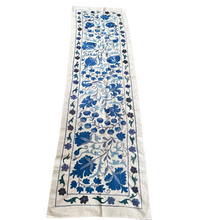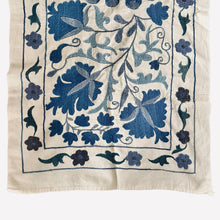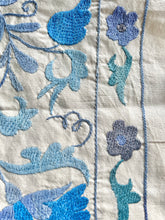Uzbek Silk Suzani Embroidered Runner
Regular price
$250.00
Sale
Uzbek Silk Suzani Embroidered Runner this vintage textile is hand embroidered with silk threads on cotton in rich shades of Blue. It has been carefully hand selected by by our design team. We inspect every vintage textile and select designs that compliment it's unique handcrafted characteristics. Every piece is a one of a kind work of art.
This vintage textile was handmade in Uzbekistan in the early 1960's, using the traditional methods. Just four stitches — tambour, basma, chain and kanda-khayol — are used to realise a large variety of patterns. The floral motif was believed to imbue the suzanis with spiritual powers, offering protection or strength to their owners.
This soft and versatile fabric can be used for many unique purposes. Frame as a wall hanging, use it on your dining table, console table, or at the end of a bed, anywhere you want a colorful and unique accent for your room.
• Please view all photos for condition, as our opinion may differ from yours.
• Please see our shop policies on returns, exchanges & shipping.
• Please pay close attention to item descriptions and if you have questions about a selection, PLEASE message us & we will be glad to help!
Please visit our online shop www.luxecurations.com for more exciting new, vintage and antique decor and accessories!
DIMENSIONS: 19" W x 72" L
MATERIAL: 100% Cotton Fabric and yarn
CIRCA: 1960
ORIGIN: Uzbekistan
*please note this item is vintage, it has not been altered so as not to detract from the vintage condition or the craftsmanship of the original artist. Expect irregularities in the fabric, and or coloration as this is what makes it a desirable collectible. We recommend gently dry brush, damp sponge to spot clean or dry clean only as necessary. Avoid direct sunlight as it will fade this textile over time.
FACTS & HISTORY: The word "suzani" is derived from the Persian word for needle (suzan) and the Iranian word (suzandozi) for needlework. Textile collectors use “suzani” to represent the beautiful embroideries from Uzbekistan, Tajikistan, Kazakhstan and other countries.
Suzanis usually have a cotton or silk fabric base that is embroidered with silk or cotton thread most commonly with the use of chain, satin and buttonhole stitches. Traditional suzanis also include couching, a delicate process in which a second decorative thread line is stitched in place over the design. They often are made in two or more pieces that are stitched together, typically include representations of the sun, the moon, flowers, leaves, vines and fruits. Occasionally fish and birds are also part of the design.
We know that suzanis trace back to at least the early 15th century, since the Castilian ambassador to the court of Timur, Ruy Gonzáles de Clavijo, wrote detailed descriptions of embroideries at the time. The oldest surviving suzanis date to the late 18th century.
Central Asian brides often made suzanis as part of their dowries with the bride presenting her handiwork to her groom on her wedding day. When times became hard, the married couple might trade the suzanis to traveling gypsies for food or other goods. Otherwise, they became part of the family’s cherished possessions.
The art of suzani reached a peak in the 19thcentury, as Uzbek women created intricately detailed embroidered bed and table linens and prayer mats for their homes and for their daughters' dowries. Working on the textile panels was an important way for Central Asian women to express themselves. Tradition tells us that a mother would begin working on a suzani as soon as her baby daughter was born. As the girl grew, she would work with her mother on the craft until it was completed for her dowry. These pieces are highly prized by textile collectors today.












